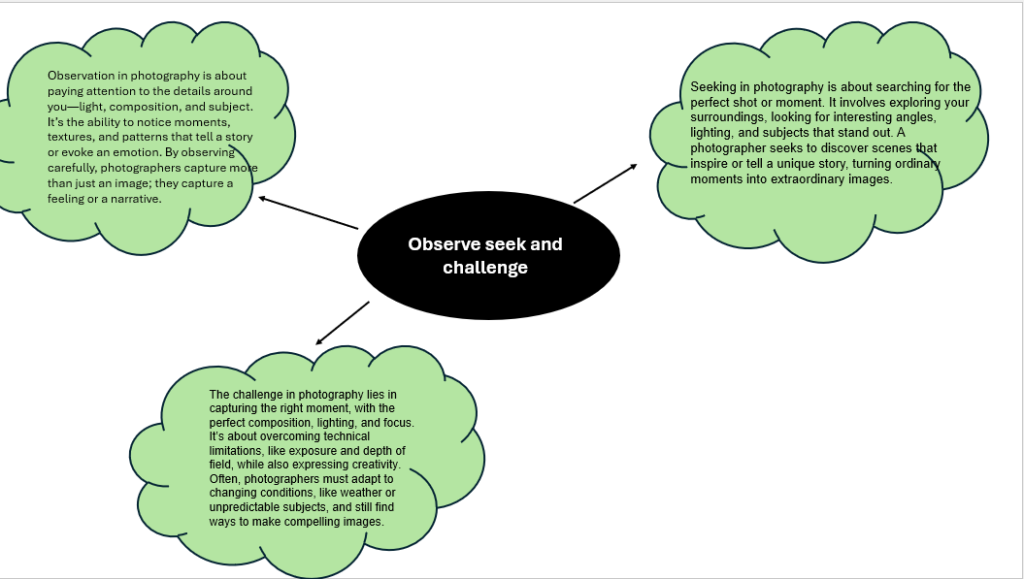

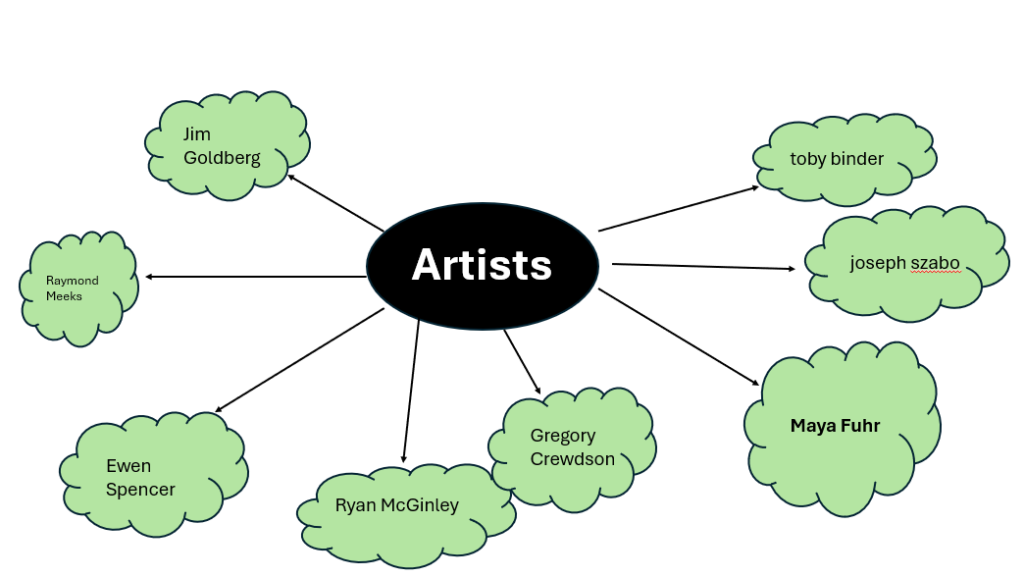
- Cindy Sherman
- Lorna Simpson
- Jim Goldberg
- Jo Spence



Justine Kurland
Justine Kurland was born in 1969 and is an American fine art photographer, based in New York City. She first gained public notice with her work in the group show, called Another Girl, Another Planet (1999), at New York’s Van Doren Waxter gallery. The show included her large c-print staged tableaux pictures of landscapes inhabited by young adolescent girls, half-sprites, half juvenile delinquents. This was her first exhibition of a photographic interest that lasted from 1997, when she began taking pictures of her mentor Laurie Simmons’s babysitter and her friends, to 2002. Altogether, Kurland published 69 pictures of girls in a series called “Girl Pictures.” The staged photos take place in urban and wilderness settings, with girls depicted as though to imply they are runaways, hopeful and independent. As landscapes she chose the ‘secret places’ of late childhood; wasteland on the edges of suburbia, ‘owned’ only by a feral nature and unsupervised children. Her book Spirit West (2000) featured similar work on a more ambitious scale. In early 2001 Kurland spent several months in New Zealand, where she created similar work with school girls there.
About ‘Girl Pictures’
‘The girls were rebelling. The girls were acting out. The girls had run away from home, that much was clear. They were trying on a version of themselves that the world has thus far shown them was boy.’ Floating a raft down the Mississippi. Tucking smokes into the sleeve of a T-shirt. Having a rumble. Living off land. Cowboys, sailors, pirates, hitchhikers, hobos, train hoppers, explorers, catchers in the rye, lords of the flies- you name it, all the dominion of boys. If you wanted a place in the narrative, you had to imagine yourself inside of it. – Justine Kurland.
This is the first paragraph in Justine Kurland’s book, where she sets the narrative of her ‘Girl Pictures’ for the viewers. The narrative of this story is that these girls have ran away from home, so that they can explore and have fun and be whoever they wish to be. She sets this narrative in these tableaux images, by having the girls pose doing all these different activities, such as swimming in rivers, or camping in forests.
She also explains what she wants the viewers to take in from this book and from her images, which is that you too can be anything you dream of in your imagination. She states that they are pirates, cowboys etc, because in ‘Girl Pictures’ these girls aren’t just girls, they are whoever they want to be, as they are finding their true identity during their youth. She also states that they are trying on ‘boy,’ because in society standards it is more socially acceptable for boys to act in this rambunctious manor, rather than girls. This is due to gender stereotypes, which have been seen through many centuries. I feel like in this book ‘Girl Pictures’ she is trying to fight against these stereotypes of young girls, and this is an important matter to her and all other girls, because they have grown up being told what they should be or how they should behave a certain way due to their gender. She is fighting against these stereotypes, by having these young girls act in a way that is seen as more masculine and not socially acceptable for these girls.
Kurland also began dating women shortly after completing her ‘Girls’ series, working with an undercurrent of sex and female sexuality. As of 2018 she had been dating her current female partner for three years. I think that, because of her work fighting against stereotypes and researching identity, it has impacted her and also allowed her to fight stereotypes and socials norms in her own personal life and help her find her true identity.
‘Girl Pictures’ is also about finding your identity and exploring youth as ‘girls’, because during youth you do not know who you fully are yet and being able to explore every aspect of your youth, even if it does not comply with social ‘norms’ allows you get the truest sense of your identity possible. Justine Kurland presents the girls finding their identity throughout the the book, because she states and presents, ‘Cowboys, sailors, pirates, hitchhikers, hobos, train hoppers, explorers, catchers in the rye, lords of the flies- you name it, all the dominion of boys. If you wanted a place in the narrative, you had to imagine yourself inside of it.’ This quote states that the girls could be anything they wanted to be even if it was the boys ‘dominion.’
Importance of the Topic
This topic of girlhood is really important to me and all other girls, because it explores our identity and youth. The way Justine Kurland opposed social norms in this book is important for girls all over the world, especially young girls that are exploring their identity, because this may influence people to decide their own identity, instead of following social standards.
Justine Kurland also explores opposing female stereotypes, which is really important to women and girls all around the world, because this will allow and influence other women and girls to oppose these stereotypes as well, so that they can be anything they want to be, instead of just confined to a certain range of lifestyles and careers.
The importance of this topic for me during my personal study, is that I can relate to Justine Kurland’s work, as well as adding my own experience, as I have experienced girlhood and youth. This will allow to me explore my youth and see how my identity has changed through the course of my life. I really want to explore this, so that I can figure out my own identity.
Girl Pictures

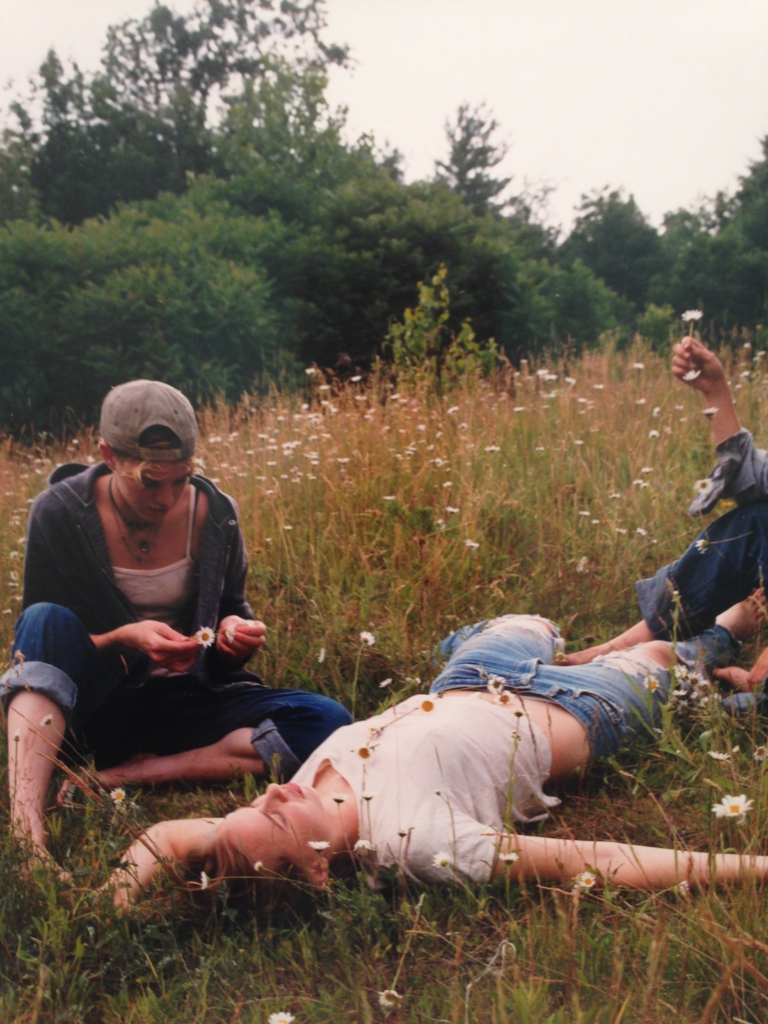
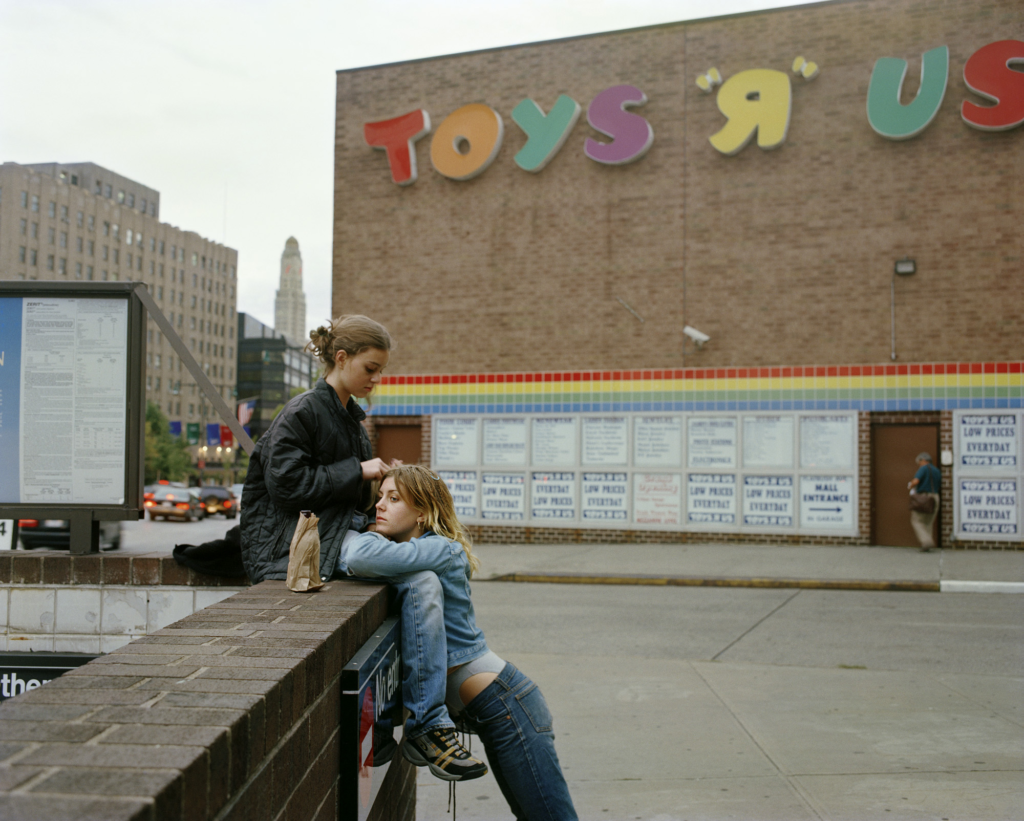
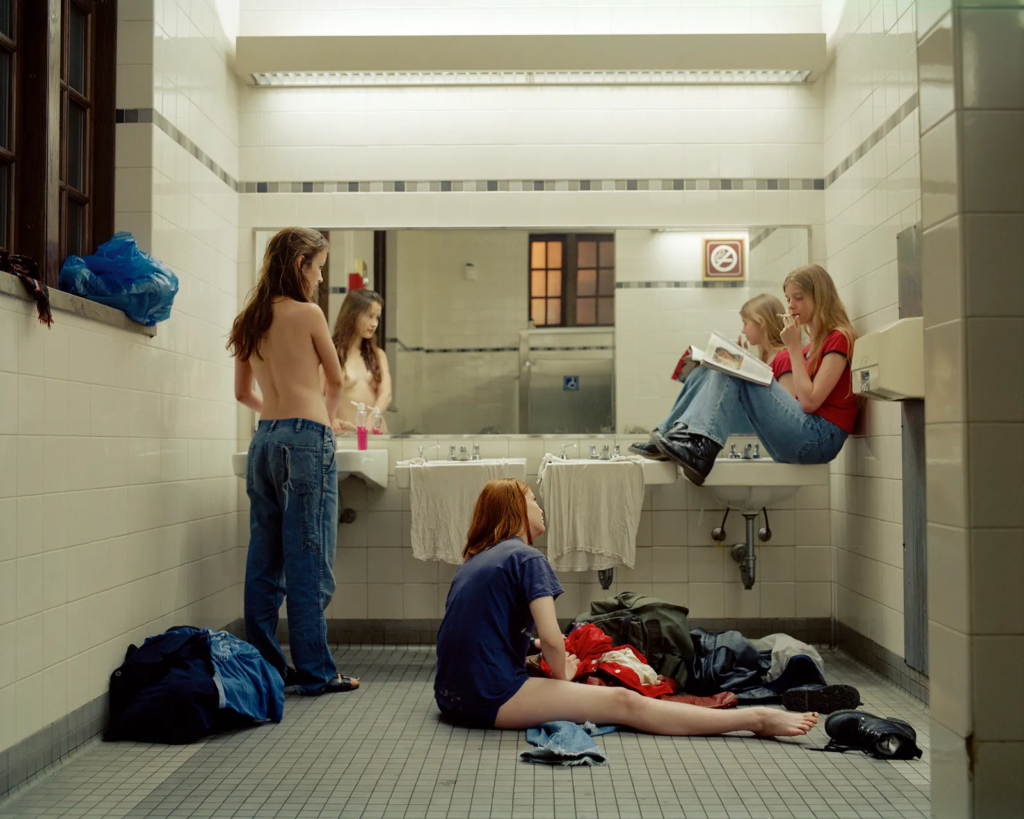
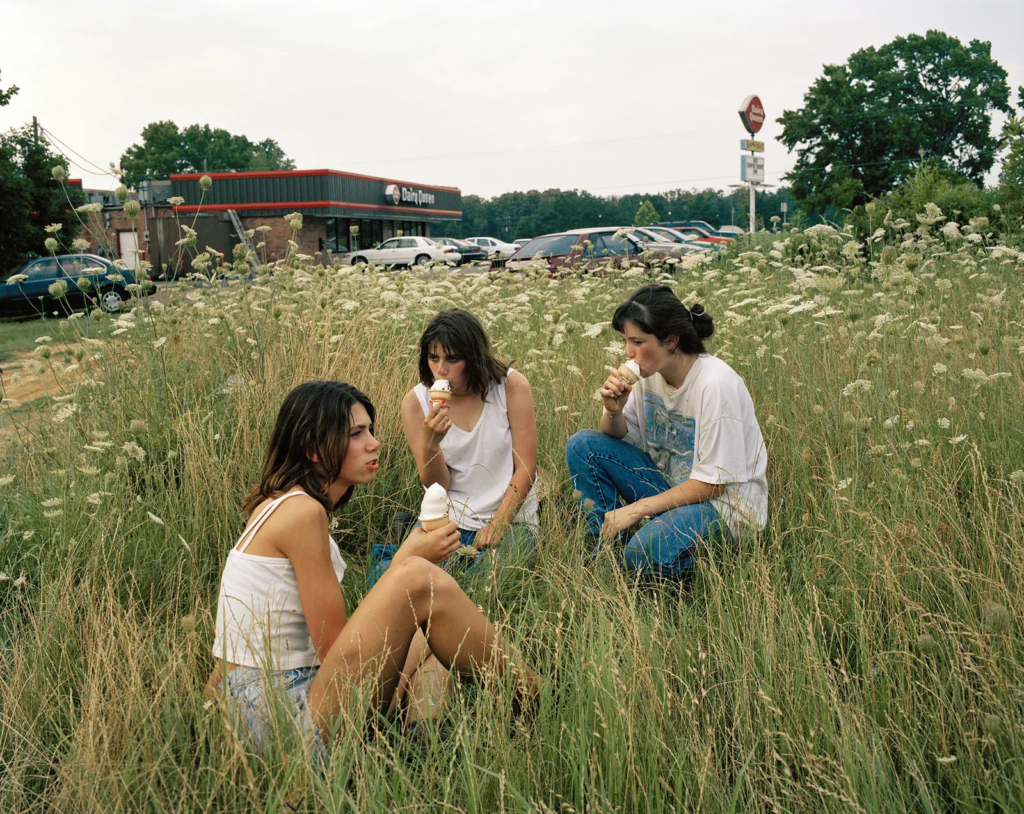
Composition
Justine Kurland carefully composes all her tableaux images, as she manipulated the narrative to be whatever she desires. She manipulates the position and distance of the girls and herself, to create a good composition.
Justine Kurland borrowed ideas, concepts and compositions from old historical paintings (masters/ famous paintings). An example of her borrowing from a master is ‘Le Dejeuner sur l’herbe’ by Edouard Manet, which was created in 1862-63.

This painting includes a nude women in the foreground of the painting, who is lunching with two fully dressed men, who are in the middle ground of the painting. They also seem to be having a picnic in a woods, which is presented by the setting of the painting and the picnic basket containing fruit. This suggests they are lunching, as the title of the painting states. ‘Le Dejeuner sur l’herbe’ is French and states ‘Lunch on the grass.’ There is also a half dressed women in the background of this painting, who is washing herself/ swimming in the lake. This painting was very scandalous back in the 1800s, as public nudity was seen as vulgar and frowned upon by society. This was because nudity was a very private concept back in that time, so the models for this painting would have most likely been prostitutes, as a respectable women would not have done this, or been allowed to in this time period.
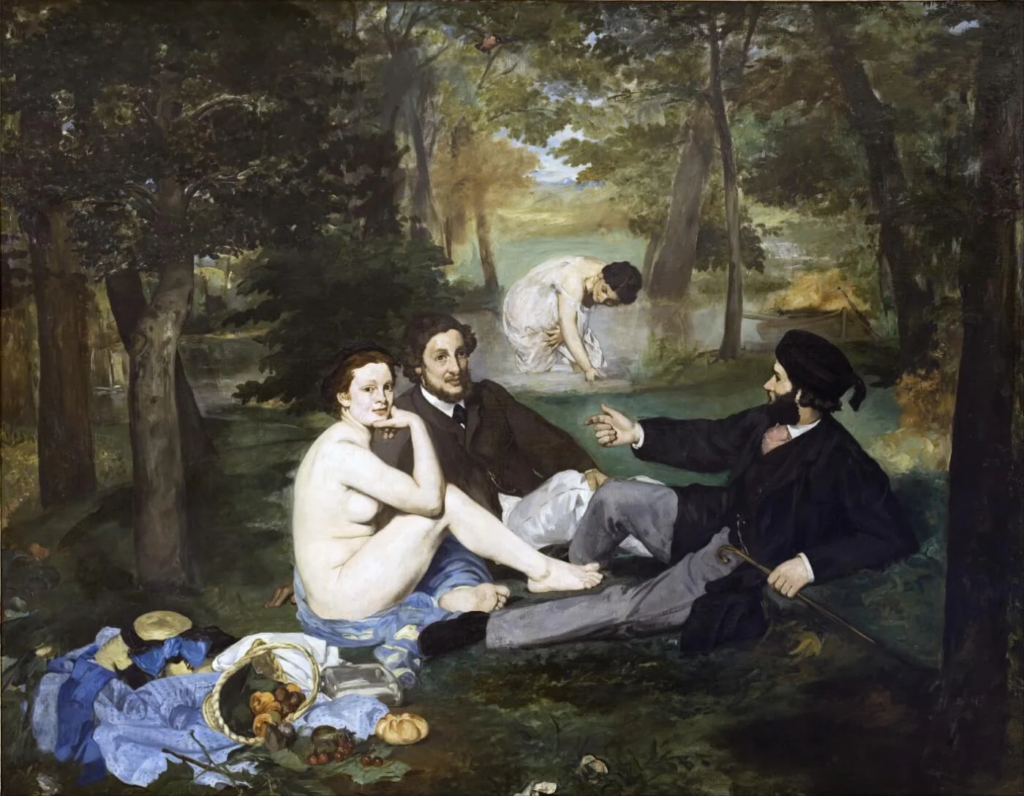
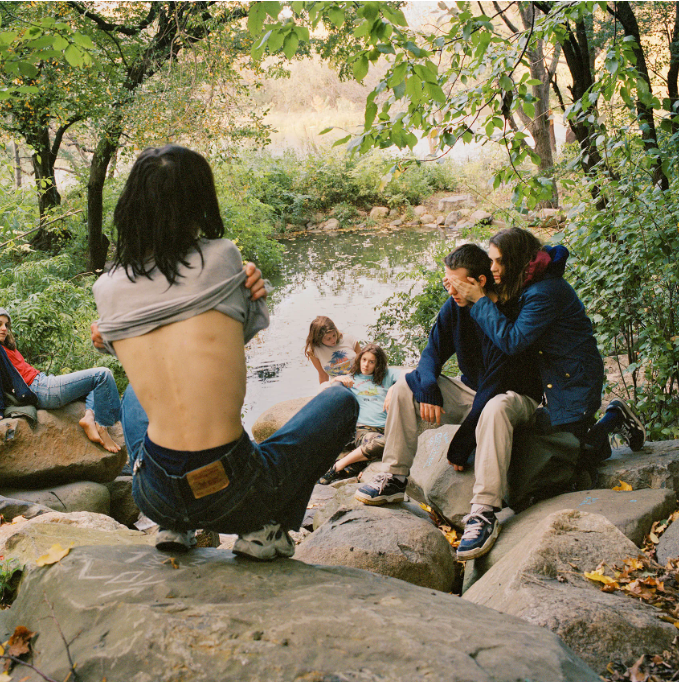
Justine Kurland borrowed the concept and the composition from this famous painting. As seen in the painting and the photograph, the settings are quite similar, as they are both scenic landscapes, which are wooded, with trees in the distance, as well as the lake in the background. She has also borrowed the nudity concept from the painting, as she has a young girl lifting her top in the photograph, as if she is undressing to get in the lake. She has also borrowed the composition from the this photo, as well as other visual elements. Justine Kurland has used the same layout of having the ‘nude’ girl in the foreground, with people in the middle ground, as well as more people in the background down near the lake.
Analysis of one image

The lighting used in this image is artificial lighting, because the image is taken inside. The image also has a high level of control, because it is a staged tableaux image, where the girls position, distance and location was manipulated the way Justine Kurland thought best fitted. This image is a colour image and has quite warm tones throughout out, because of the warmness of the light (not a harsh florescent light). The layout of these girls was manipulated, so that there was a foreground, middle ground, and background, which leads the viewers eye around the page from front to back. This make the girls the main viewpoint of this image.
This photograph displays ‘run away’ girls living out of public restrooms, as they are exploring their sexuality and ‘trying on boy.’ This photo is largely about fighting against stereotypes, as they are acting in a way that is seen as more masculine. These images are also about exploring identity, because in these images the girls can be anything they want and desire, from princesses to cowboys and more.
What I am taking Inspiration from
I am taking inspiration from the way Justine Kurland takes her images. She takes tableaux staged images, that look like candid shots, which is what I am going to replicate for my own personal study. She also takes pictures of young girls doing a range of activities, ranging from camping to shooting. I am also going to be taking pictures of a group of young girls (my friends) doing a range of similar activities, but I am also going to include a few different activities that are feminine according to society, because Justine Kurland only explored the girls ‘trying on boy,‘ so she only explored opposing female stereotypes. In my study I am also going to explore opposing female stereotypes, but I am also going to present female stereotypes, so I can present a larger range of identity in my study. Justine Kurland also has a distinctive outdoor settings in her images, including places such as the woods, rivers or roads, which I am also going to use for the setting of my images. However, I may take a few images inside, as a few of my youth memories were inside and I also want to explore these.
I also want to take inspiration from her carefully thought out compositions, that she took inspiration from old historical paintings. Not only do I want to replicate some of her compositions, as well as creating my own compositions to suit the setting an activities that are being done. I may also try and take inspiration from old famous historical paintings, just like she has, so that I can really stretch myself further and challenge myself. Some ideas of masters that I could recreate the composition of are below:
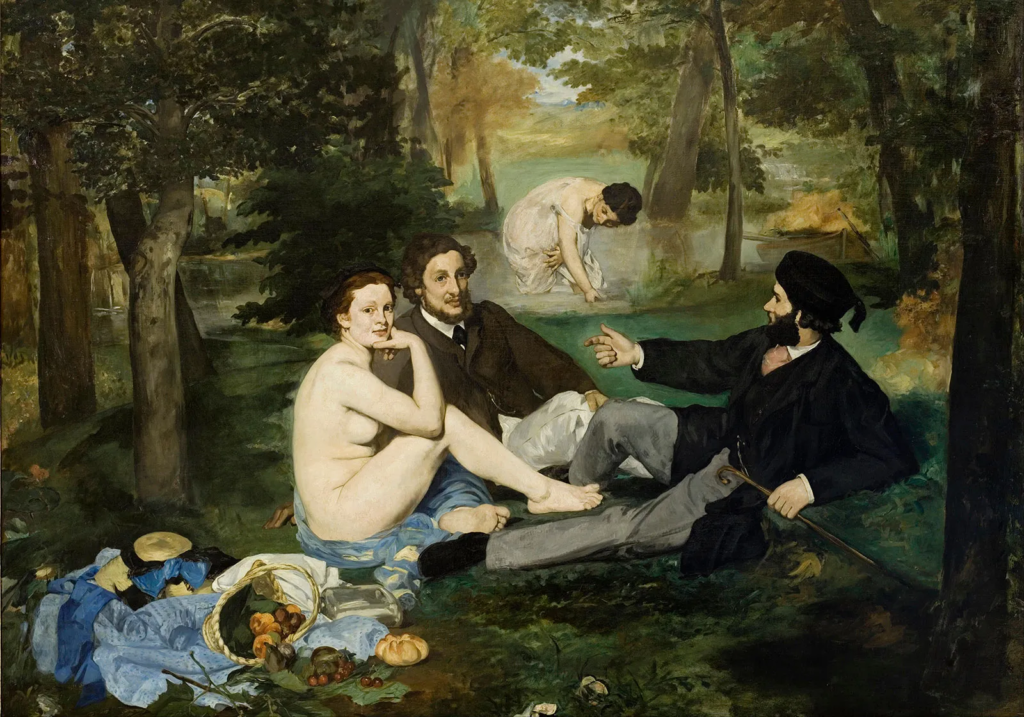
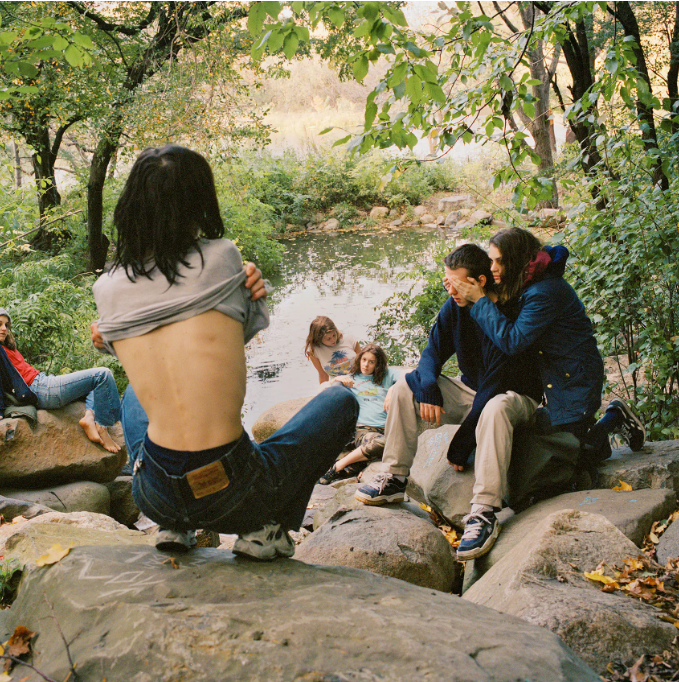
I want to take inspiration from this painting by Edouard Manet, because both Justine Kurland and Jeff Wall have taken inspiration from this painting. I also want to take inspiration from Justine Kurland’s photograph, which has taken inspiration from this painting.
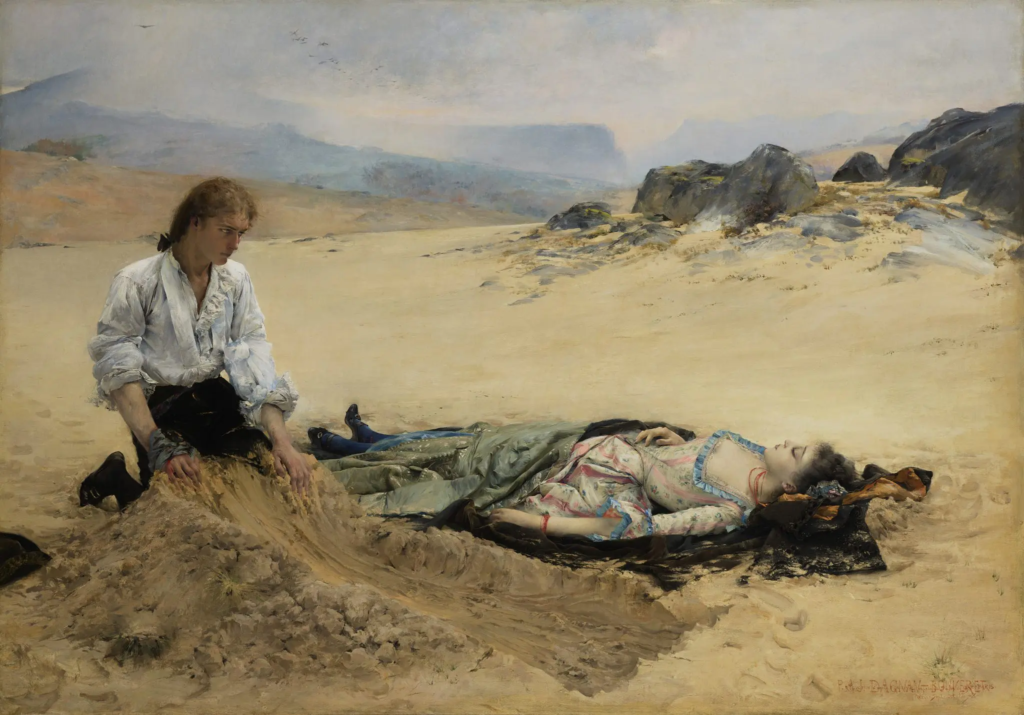
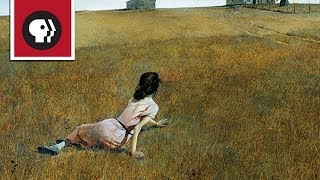
Andrew Wyeth, Christina’s world 1948.
I have chosen to recreate these famous historical paintings, because not only do they have good composition, but they also tell a story, which I feel like I would be able to present with my photographs, but make it applicable to modern day and to the theme of youth and identity, because that is what I am exploring.
Will Lakeman is a local Jersey artist/photographer. Last year he did an exhibition at Art house Jersey’s Capital house gallery, where over two thousand people attended. The exhibition was based on the former leisure centre and swimming pool at fort regent. In the exhibition Will Lakeman includes the use of AI generated images of the the former site which look surreal and are interesting as you see the AI’s interpretation of the old fort regent. However there is a lot of controversy online with AI art as it undermines and negatively impacts real artists who make a living and spend hours creating art and commissions, some people don’t even consider AI art as actual art.
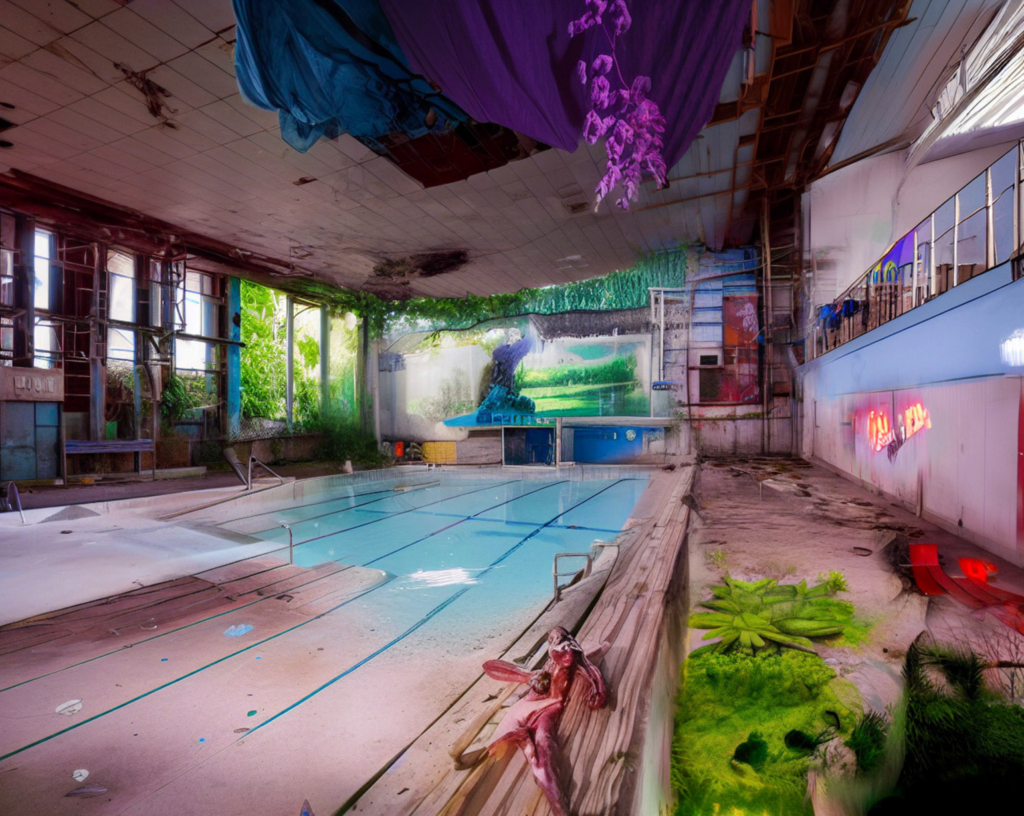
Lakeman states about his work that “Through my work I try and communicate something of the weird, vivid sensations of my dreams and nightmares.” This can explain why a lot of his photos have a dream like and in some cases liminal aesthetic to them, especially in his series ‘Lurking in darkness‘ which uses coloured gels, as well as being shot at night.
As well as Will Lakeman’s work being shown at Arthouse jersey, he has also had his work shown at the Private & Public gallery and the CCA galleries. In 2021 he was awarded the Summer Prize from the CCA Galleries International Summer Exhibition, this shows just how creative and good his photos are, which I personally find that they are all interesting to look at especially as most the photos are taken locally.

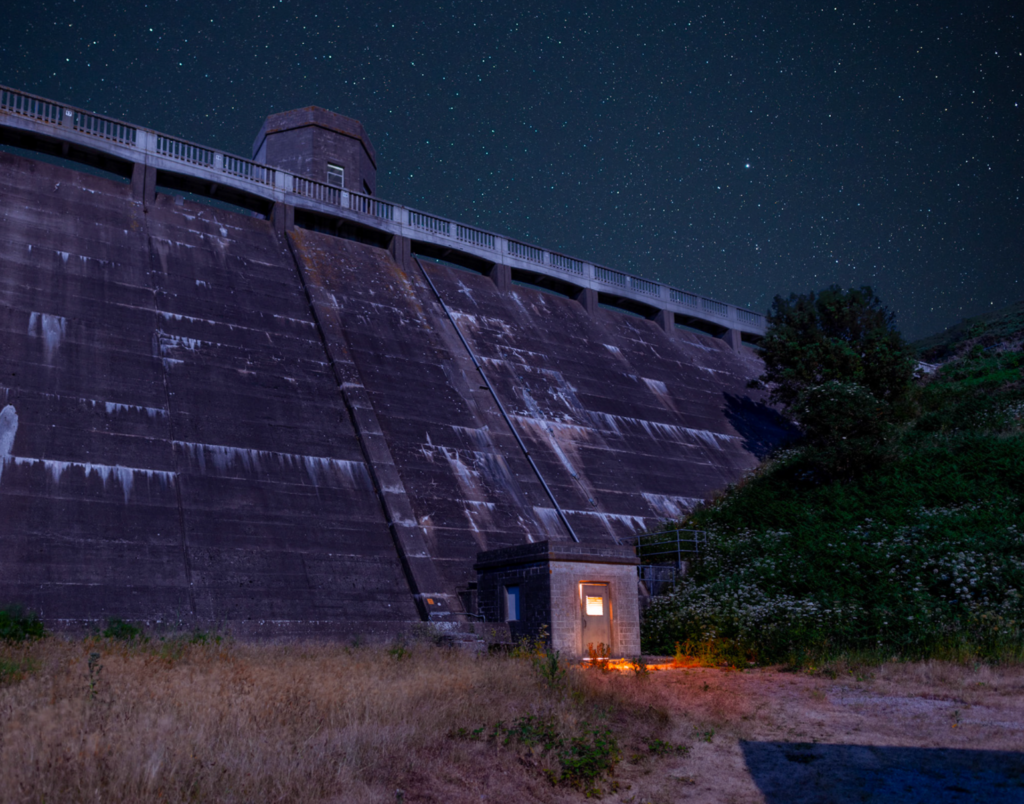
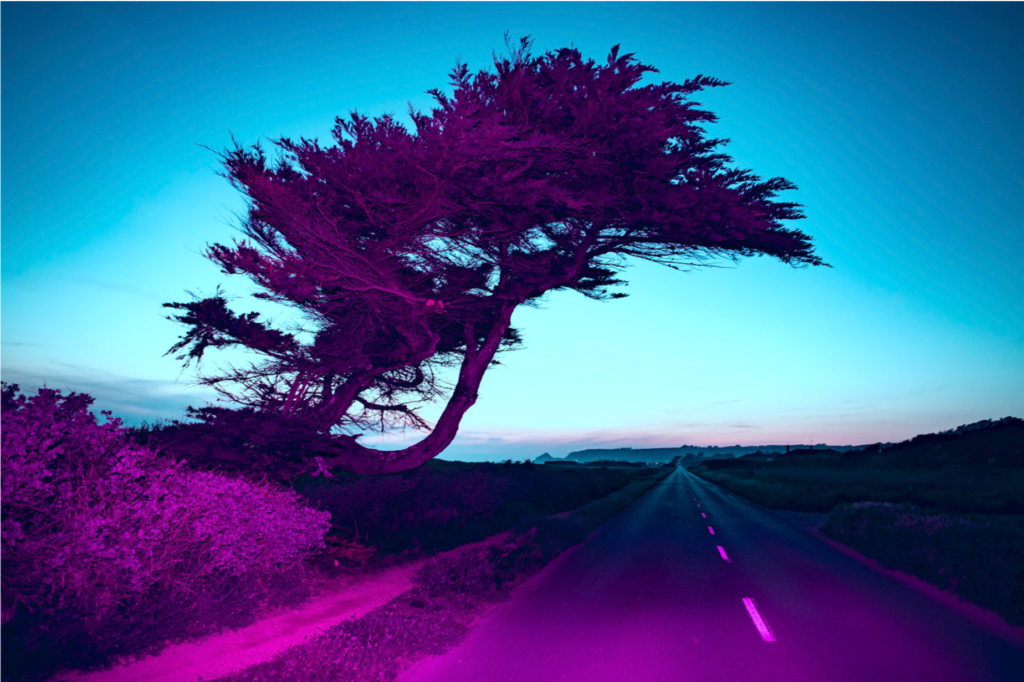
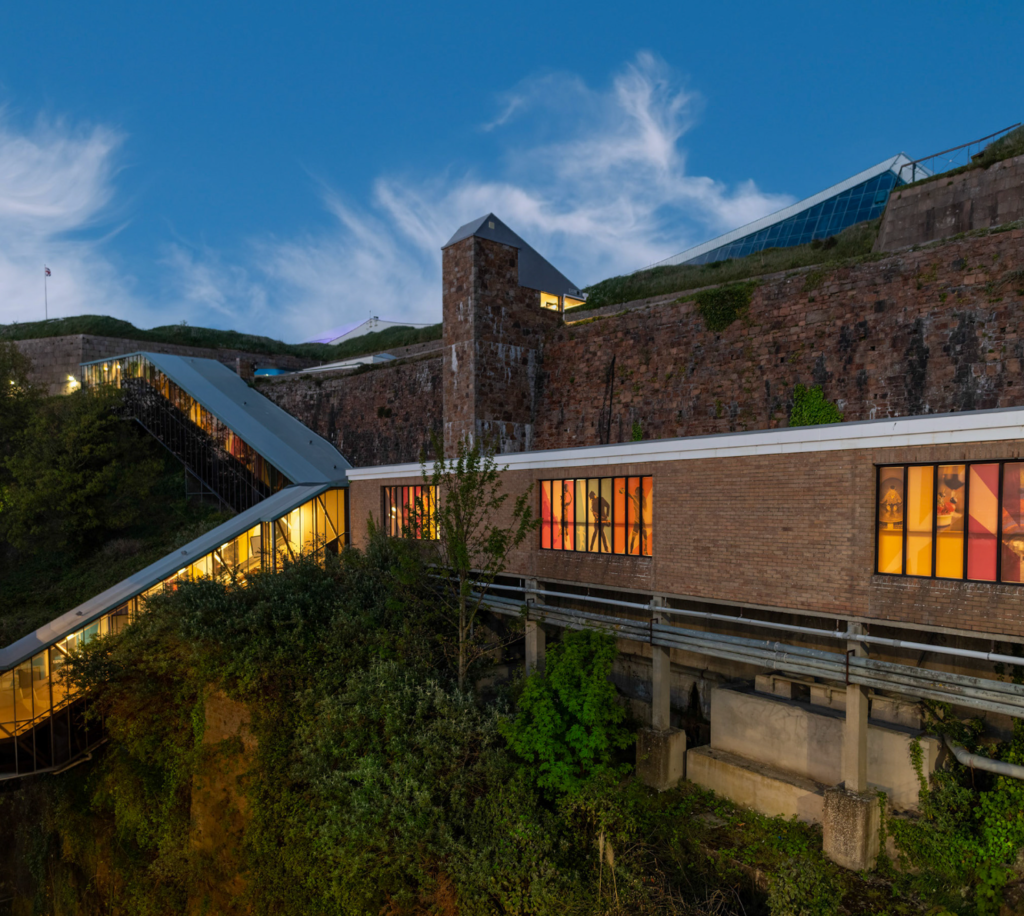
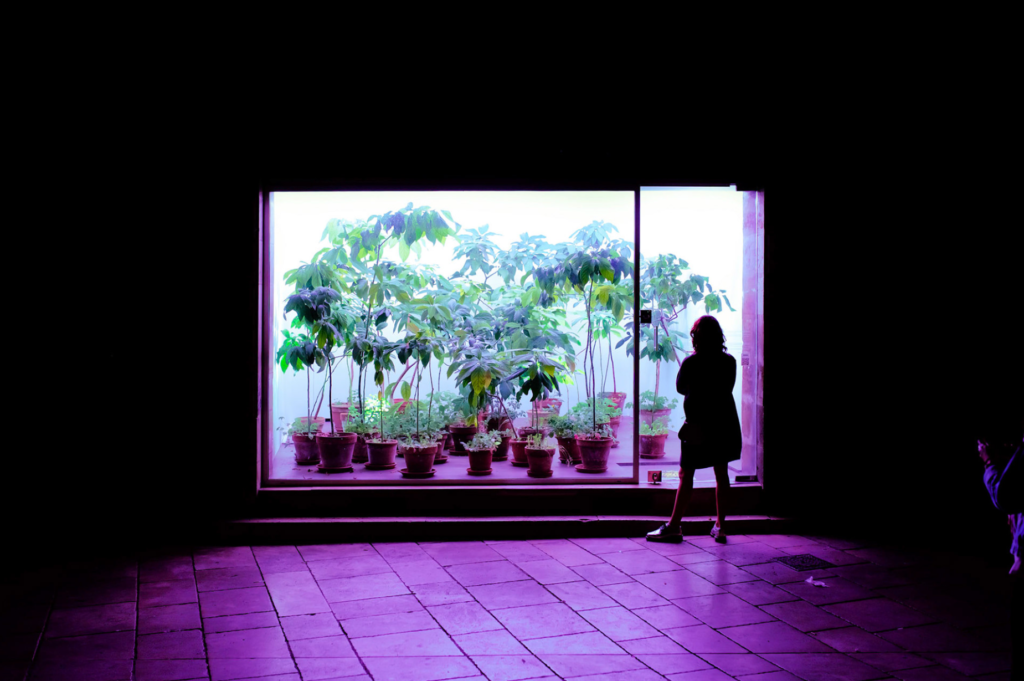
This photo was taken by Will Lakeman in 2020 as part of his series of photos called ‘Lurking in darkness’ with Will describing the series as “I love to explore the world at night. I aim for these images not to represent reality, but to explore my dreams and fantasies.” which can be seen in this photo, which has a dreamlike and even liminal aesthetic to it due to multiple factors.
The first factor is due to the sense of unknown. We know nothing about the person looking in the window or even the location, as the background is completely black and there is little to nothing in the photo that provides context. The second factor is the strangeness of the photo. In the photo, we see a woman looking through a window, which is in the centre of the image and is the main subject of the image. On the other side of the window, there are lots of potted plants. This sense of strangeness reflects dreams, as dreams can be strange and random and contain elements of the unknown, providing mystery and making people want to seek answers.
The lighting is also quite interesting in the photo, all the lighting is artificial and the white light looks really bright especially as it contrasts with the darkness of the rest of the image, there is also a really nice purple shadow coming from the window, made from coloured gels, which provides light to the foreground of the photo. The lighting also helps contribute to the dream like feel of the photo. The cool white and purple from the lighting gives the photo a cold feel to it and may imply that the dream is not inviting or positive and may reference that the photographer’s dreams are not enjoyable or wholesome ones.
My first artist : Ansel Adams Mood board
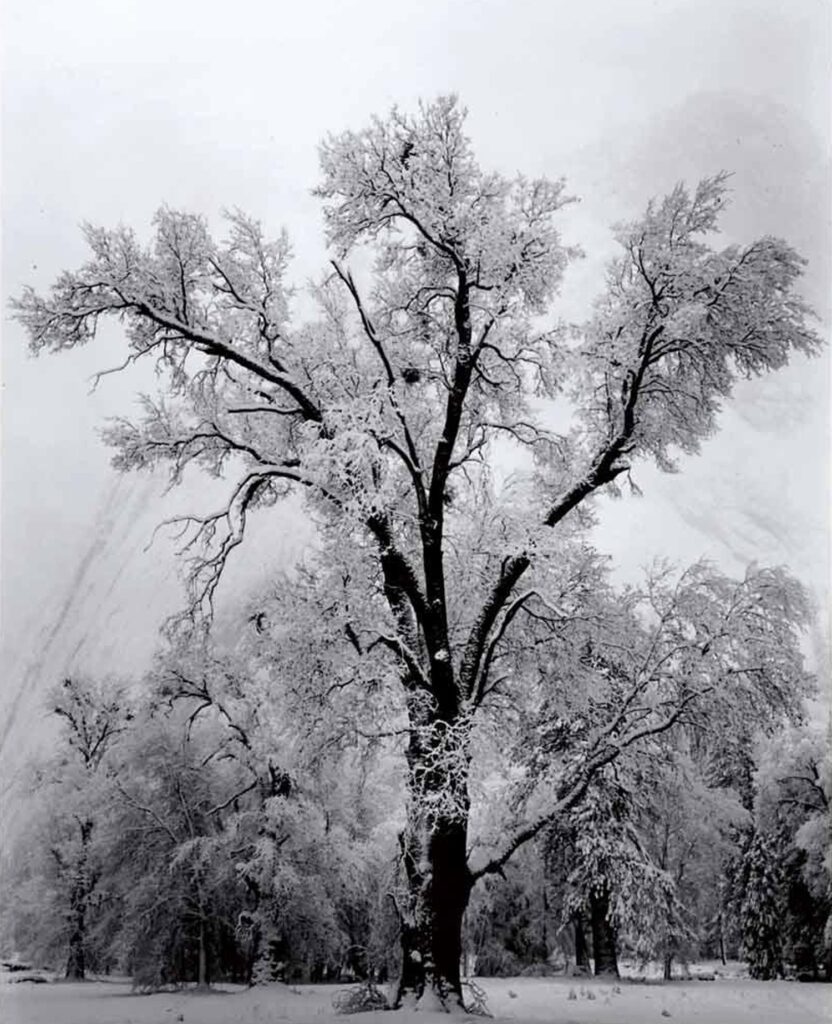



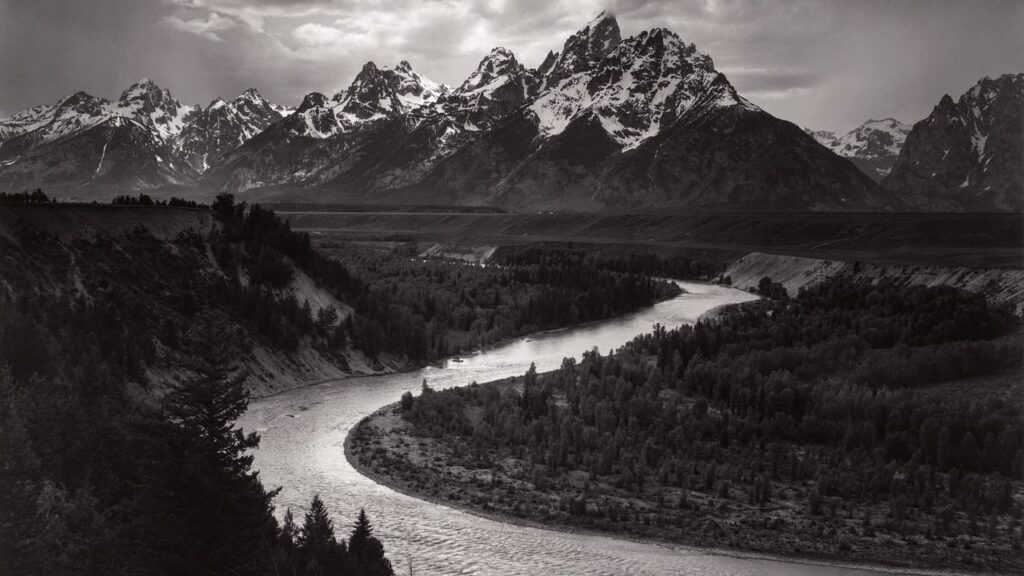
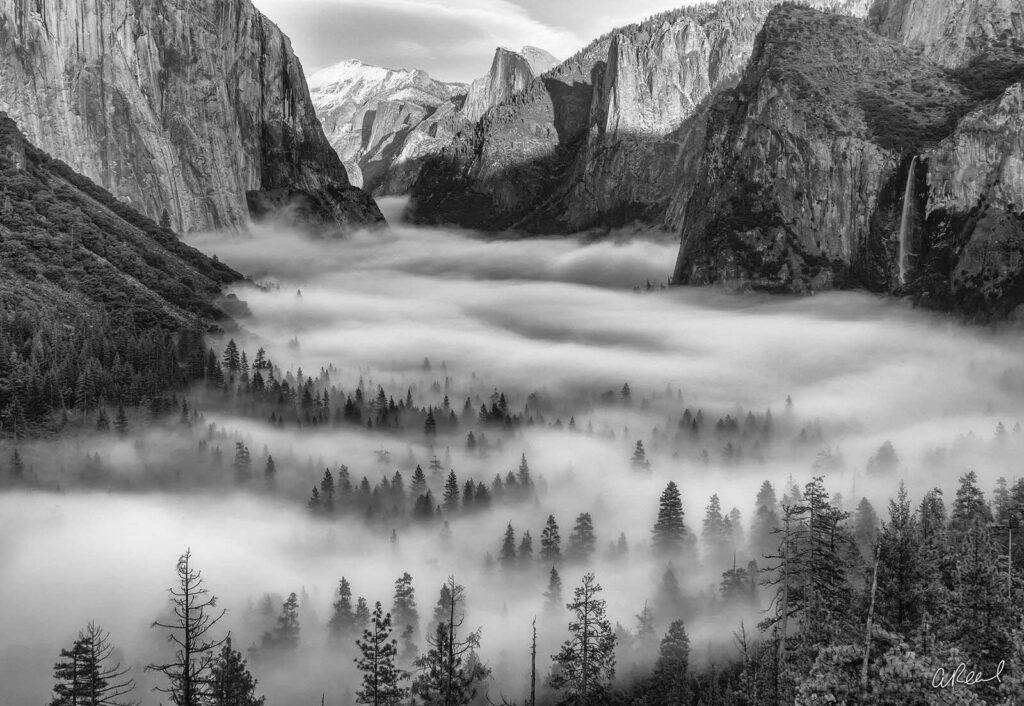
Overview on Ansel Adams Photography
Ansel Adams is a landscape photographer and took most of his images of the environment, usually trees and flowers or picturesque landscapes from the top of mountains and rivers or taking images of these magnificent landscapes looking up from the ground to show the sheer size and enormity of these mountains. His photos are all in black and white and his images are very heavily shadowed which emphasizes the key features of the photos such as the image with the river because the mountain in the background is so heavily shadowed and the river has the sun beams reflecting on it, the river stands out very clearly against the dark shadows making it clearer to see the leading lines of the image.
Why I chose Ansel Adams?
I chose Ansel Adams as my first artist because he photographs the beauty of nature and life. His work looks at high contrast black and white images of the American west specifically showcasing the natural beauty of trees. His tree photographs almost give a new life to the images and show the trees in a different light making them look much more appealing than how they looked before they were edited to be high resolution black and white images.
Ansel Adams Photography

Ansel Adams photography is of lots of living nature such as trees and flowers and the beauty of life which contrasts against my theme for my book which was about one of my grandparents life. I chose to combine these two themes because I wanted to get images of the nature and plants and put them with pictures of my grandads life to show how precious his life was and to celebrate his life. The bright white in this image of a flower shows the purity and preciousness of the flower and almost shows how special and sacred the flower is. The white balance gives the image cold lighting which makes it come across as a very dramatic and striking image and it makes it look like there is a deeper meaning behind the image.
What inspired Ansel Adams ?
Ansel Adams was strongly influenced by Alfred Stieglitz whom he met in 1933 at an American Place gallery in New York City. He was given his first camera at 14 during his first visit to Yosemite national park where he discovered his love for nature and how to show the purity of inanimate objects.
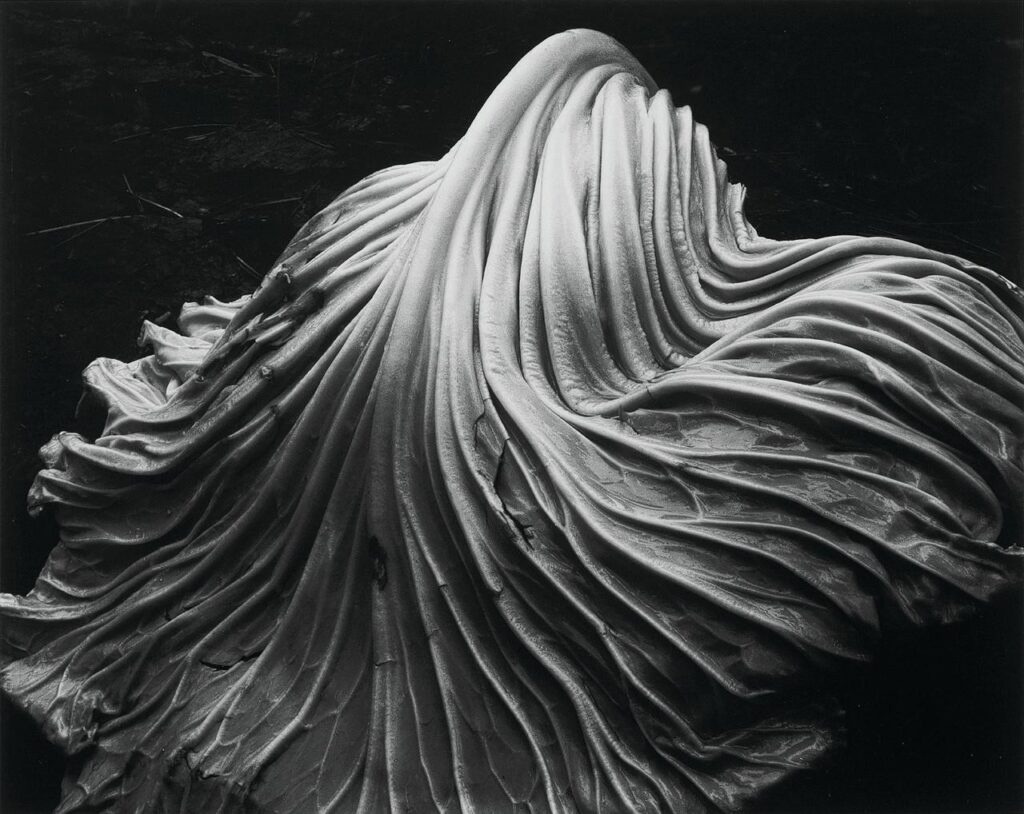
This is Alfred Stieglitz image and it shows the comparison with Ansel Adams image and how similar the lighting and the shadow is with each of the images. The shadows in both images clearly define the features of what is being photographed and show clearly the amount of detail in the image. These two photos are similar as they are both black and white images and they are taken with a very narrow depth of field and they are both very detailed images
He made Urban Landscapes and was a documentary photographer. His technical methods changed and he began to use colour film and a large format camera.
What I want to explore:
My intention is to explore the major social issues within gender, specifically women. I want to explore the themes of misogyny and stereotypes mainly, but also patriarchy, expectations of women and power dynamics while executing the female gaze. I want to execute the change of stereotypes throughout the years and the growth through each factor of the feminism waves.

Why it matters to me:
I would say, this topic matters to me because I realise as a female that women like Cindy Sherman and Nan Goldin portrayed the social issues within gender in the 1970’s but Sherman was portraying the traditional stereotype in the 1950’s. This is important to me because, although stereotypes have changed in a way, women are still expected to be a certain way even in the 21st century. This subject matters to me as there is still a significant power dynamics within gender. Women feel the pressure a lot more than men within beauty standards, and feeling the need to be a service to men still to this day, especially including the change in beauty expectations throughout the years.
How I wish to develop your project:
I wish to develop my project by taking images fitting the traditional stereotype similar to Cindy Sherman in the kitchen and other traditional settings. For example, I plan to take images of a female dressed up for the man meanwhile doing household work for the man. Within Cindy Sherman’s images she uses the female gaze which is a very important element that sticks out to me. This is because the ‘ female gaze’ adds a slight sexual and objectification element to her images which is to present the representations of a woman. To emphasize this, she uses a heavy amount of eye makeup so it cannot be missed. Sherman focuses on to ‘ Deconstruct a woman’. Sherman’s objective really stood out to me as she is attempting to deconstruct and portray how woman really felt in the 50’s. Not only this, posing is a very important factor such as possibly doing poses to show an element of motherhood and nurturing which is a typical stereotype of women. To develop my project, I will also be purposely setting up props such as kitchenware to emphasize my images like Sherman. However, I also plan to take images next to a book shelf like Sherman as this links to the second wave feminism as women were not seen to be educated. Instead they were only seen to be a nurturing mother and look after the household. Overall, in my opinion setting is almost the most important factor and will be very thought through as I personally believe it is what makes the image understandable. I plan to successfully execute this through using props etc and placing them in the correct areas to make the image the most interesting and eye catching.
Which form I wish to present your study (photobook, film, prints etc)
I wish to present my study in a photobook, I think this will suit my project best as I want to present the different types of traditional stereotypes in different settings, clothing etc which I can execute as my images are purposely suppose to look planned and thought out, rather than natural. This takes the sense of reality away which is what I aim to do so. In my photobook, I wish to show the different stereotypes throughout the years. My first set of images would start around the 1950’s and end in modern days around this century. This would mean I would be able to show the growth in stereotypes women face which is relevant as second-wave feminism was a period of feminist activity that began in the early 1960s and lasted roughly two decades, ending with the feminist sex wars in the early 1980s and being replaced by third-wave feminism in the early 1990s. Therefore, the traditional ‘housewife’ stereotype has significantly changed throughout the years yet there are still expectations. This stands out to me and I wish to show this change successfully as you turn the pages.
When and where you intend to begin your study?
1st wave-
I aim to begin this study this week in my household or in a library. This is to purposely signify the 1st wave of feminism which was the suffrage movement aiming for voting and equal rights. I aim to take some images of the subject picking out a book from a bookshelf, portraying the female gaze. The reason this is my idea I wish to execute is because this makes me think of women gaining the rights of education and voting. This links to the Cindy Sherman concept of ‘ Deconstructing a woman’ as it was a typical stereotype that women should not be educated, and were only needed for motherhood and for the male in the looked after household. This is the starting point as this was in the late 19th century to early 20th century. The first ever movement females had gained. The female gaze is suppose to add a significant photography feature as the purpose of the ‘female gaze’ becomes to connect with the female viewer via the female creator, coming together in a way that serves them, and upholding the idea that women are powerful and can control their own destiny. That is why one of the most notable differences between the male and the female gaze is intent. First-wave feminists argued that women were only “inferior” because of their inferior education. If they were educated at the same level and to the same standards as men, they would be able to exercise their reason at the same level as well, and would hence deserve to be treated as full equals by the law. This is why I think my images will be relevant to this timeline.
2nd wave–
My objective within the second wave is to take images in my kitchen, with the subject female dressed up for the male in the ‘household’. This is because this portrays a factor of the power dynamics within gender. Because of this, I aim to portray the ‘traditional housewife’ as this stereotype began in the 2nd wave. To do this successfully, I aim to have my subject in the kitchen doing chores, such as cleaning and cooking. Things to emphasize this could be the subject in an apron, hair rollers, heels and a significant amount of makeup to portray the female gaze. Another factor that I was inspired by was Cindy Sherman’s posing such as her arm around her lower tummy. This signifies the nurturing mother stereotype as well.
3rd wave–
My objective within this photoshoot is too take images of a women of colour with more freedom such as in a club, party etc. This is because I was also inspired by Nan Goldin’s work which she still portrays an element of feminism yet a lot of her work is not entirely focused on it. She has this famous image in a nightclub during the 80’s.
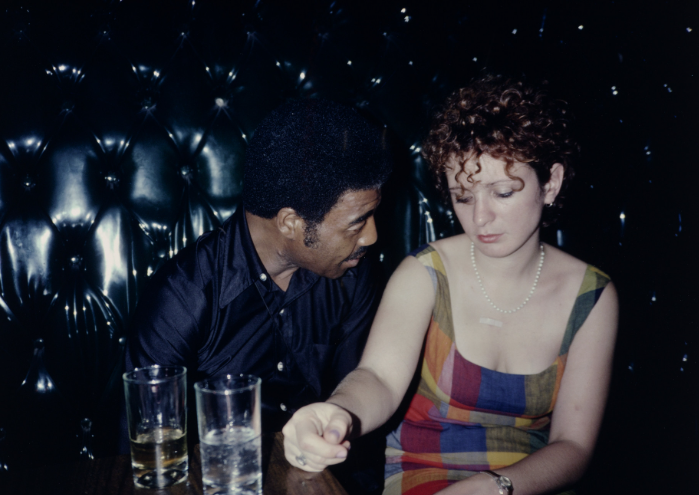
Therefore, I will take images of a woman of colour potentially drinking or at a free place because it represents the growth in equality within woman. I hope to keep the subject formal and feminine such as dressing her such as a long dress and potentially heels and heavy makeup meanwhile maintaining the theme of the female gaze. The third wave of feminism, which began in the mid-1990s, is generally regarded as more inclusive of women of colour than previous waves and is credited with bringing the notion of intersectionality to the forefront of mainstream feminist activism. The third wave broadened the agenda of women of colour so I am to merge Cindy Sherman’s and Nan Goldin’s work to make my own pieces.
4th wave–
Within this photoshoot, my main aim is to take images of a female looking at the expectations within social media or comparing herself to social media in the mirror. I am inspired by Cindy Sherman in these images

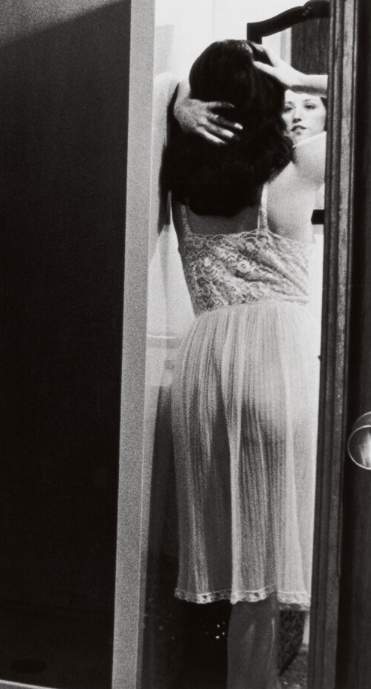

I think these photos have such an impactful message which I am mine to do so too. I aim to take images mainly in a mirror of a woman doing ‘stereotypical’ things such as makeup and crying as a women are seen as sensitive. However, at the same time I aim to show the impact of social media and although it signifies the freedom and equality rights of women, it has a very impact of teenagers and even women. This will be aimed for 2010’s to 2024 which is the present. Not only this, I will make my subject to dress up to still show the feminine side and how the dressing up from the man in the household has switched to social media. I think this will successfully show the growth and impact of feminism and I aim to put it in order in my book to emphasize it. All my images I am to be mirrors and staged as I think this will suit my ideas the best.
What I want to explore:
Within my personal study, my main themes are femininity and youth. I want to explore these themes because feminism is a movement to put an end to sexism, sexist exploitation, and oppression and to achieve full gender equality in law and in practice. I feel passionately about the role of women and how society has shaped stereotypes surrounding them, as well as looking into how women have overcome these stereotypes since the 1950s, which links to the ‘Challenge’ element within the project. In addition, I chose youth as one of my main themes because youthhood is the time in our lives that teaches us how to make decisions and start making reasonable choices. This is an element that I relate to as I am currently in my teenage years and learning how to make important decisions for my future, therefore this topic is something I can apply my own experiences to which will give my work a more realistic approach. From my artist inspiration I gathered that Kurland depicts a dream landscape, and a world where even imaginations of resistance are misshapen by white supremacy. These two themes also link to women stereotypes and gender roles, which are two other specific topics I will be diving into. The main issue I will be researching is women stereotypes, where I have looked at Cindy Sherman as well as Justine Kurland. Sherman is a photographer who probed the construction of identity, playing with the visual and cultural codes of art, celebrity and gender. I took inspiration from these two artists specifically because I feel that they take their own unique approach to the social issues and portray their work in contrasting ways.
Why it matters to me:
“Your identity plays an important role in how you treat others and how you carry yourself in the world.”
This quote highlights the importance of everybody finding their own identity and how they want to portray themselves to the world. I believe this is significant because it is part of the message I want to present, encouraging young girls around my age to express their true identity. Moreover, identity is becoming a more spoken-about topic in my generation, where we have become more accepting of people collectively. This photoshoot matters to me because it obtains the theme of youth and gender. This is because youth is a inevitable element of reaching adulthood and everyone’s is unique. As well, I am able to include elements that are more specific to girls rather than girls and boys, as males and females grow up very differently from each other. I want to incorporate these ideas into my photoshoot so I can take my own approach to these themes. By including these ideas into my photoshoot, I will be able to relate to the ‘Girl Pictures’ book through my own experiences through growing up as a girl and using models that are of a similar age to the young girls in the book. This way I am using my artist inspirations effectively but making it more personal to me.
How I wish to develop my project:
I wish to develop my project by including similar elements as my two artists; such as taking photos outdoors with a natural background, or focusing on presenting gender roles through photographing young women showing stereotypes, for example in a kitchen. This way I will be able to portray similar outcomes to Kurland as she focuses on taking images of young girls who have ran away from home and are living outdoors. I feel that I can recreate this successfully by going to St Catherine’s woods and placing my models in different locations of the woods, often holding objects that represent girlhood such as a hairbrush. I am also able to relate to Sherman by photographing girls portraying female stereotypes because that was what she focused on. For example, I will use the ‘female gaze’ in my images as it adds a sexualized and objectifying effect into my images which shows the representation of women in the 50s. Sherman focuses on “Deconstructing a woman” as her photos are often interpreted as feminist art, since her works raise questions regarding the objectification of women by the male gaze and the construction of the female gender.
Which form I wish to present my study as:
I wish to present my study in a photobook, as I feel that this will best represent the structure and messages behind my photoshoots. For example, at the beginning of my photobook will be my Cindy Sherman inspired photoshoot, as these images highlight the stereotypes of women in the 1950s. This way, I will be able to present my photos in a chronological order, which makes it easy to understand yet also interesting for the viewer as they will get to see how women have changed and adapted to the gender roles of women. My aim is to make my images seamlessly blend together by taking my photoshoots in similar locations. Then my photobook will begin to incorporate Kurland’s images, as hers were based between 1997 and 2002. Sherman’s photographs were taken when coloured photographs did not exist, therefore I will include black and white images throughout my photobook to keep my inspiration surfaced. Contrastingly, Kurland’s photos are all in colour, which gives an overall more modern aesthetic. I will also include these but mostly towards the end of my photobook so the chronological order of them is displayed. Additionally, I may include pages where I show a typology of images on one page, this way it is easy for the viewer to see the similarities and differences between the two artists and what they aim to present in their work.
Where and when I intend to begin my study:
I intend to begin my study with lots of images inspired by Sherman, including black and white images to show the time they were taken. I will take my first photoshoot inside, only using one model. My main location will be in a kitchen where I will have my model portraying typical women stereotypes in the 50s, yet I will take inspiration from Justine Kurland too so the images throughout the book can merge together. For example, I will dress my model in clothing from the 50s but I will put some of my images in colour too. In addition, in my second shoot I will photograph in outdoor settings. This is because it will successfully show the theme of youth which I am trying to present through my work. In my childhood, I spent a lot of time outdoors in places such as; different beaches, specifically St Brelade’s bay, Millbrook park, FB fields etc. I want to include some of these outdoor settings in my photoshoots so I can relate my images to Justine Kurland and execute similar outdoors.




I have also previously explored this topic of women and their role in the world whilst researching Cindy Sherman. Cindy Sherman is an independent photographer who took photographs in the 70’s. Something I find particularly admiring, is how she she took her camera and pointed it at HERSELF, instead of photographing someone else. I find this very unique and actually brings more meaning and creativity to the photos she created. This gesture then became her signature thing and showed her strong views on gender and the construction of identity through key times when opinions and personalities where particularly changing in history. She also mad many different character that she would pretend to being her photos and experiment with makeup, hairstyles and costume to demonstrate these characters.
I really like the idea of femininity and women in todays age as it is a subject that I, myself live through and endure. I can also use other young women enduring this in order to convey my message. I hope to express my theories on gender and identity and how women can be interpreted in different ways and do not need to fit a specific narrative. Analysing Cindy Sherman has aided this idea as she, herself has worked on how women can be interpreted in different ways and all the multiple narratives they can fit. Although, a difference I would like to express Is a positive light on women and how they can in, fact be strong and independent compared to an idealised view of being helpless and dependent on men.
Cindy Sherman originally studied painting and began by painting self portraits of her, in which she was herself, as characters which she would see in magazines and photographs. She then began to work on altering her face with makeup and different costume and first produced 5 images of different personas such as a clown and a young girl and many others. These photos helped to soar her fascination for impersonation and self transformation.

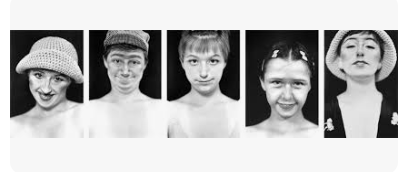
She then began to visit thrift stores to purchase new outfits for specific characters. She quoted “So it just grew and grew until I was buying and collecting more and more of these things, and suddenly the characters came together just because I had so much of the detritus from them. She then began to wear these different characters and at as them whilst attending different gallery openings.
Cindy Sherman’s work which was her most famous, was her Untitled Film Stills which are small black and white photos where Cindy has impersonated different female characters through glamourous and meaningful images. Throughout these film stills Cindy Sherman imitated different lifestyles and character stereotypes which shows how women and women’s bodies are perceived by the mass media and by the male gender. Whilst moving to New York, Cindy Sherman continued to role play in disguises and characters and photographed her imitations as the Untitled Film Stills. Although she took many of her own photographs, some photos were shot by family and friends. The voyeuristic perspective of Cindy’s work creates an imposing feeling on the viewer, as if you are secretly observing the character and she is always the subject of the controlling male gaze instead of the object of masculine desire.
Cindy Sherman’s Inspiration for Untitled Film Stills.
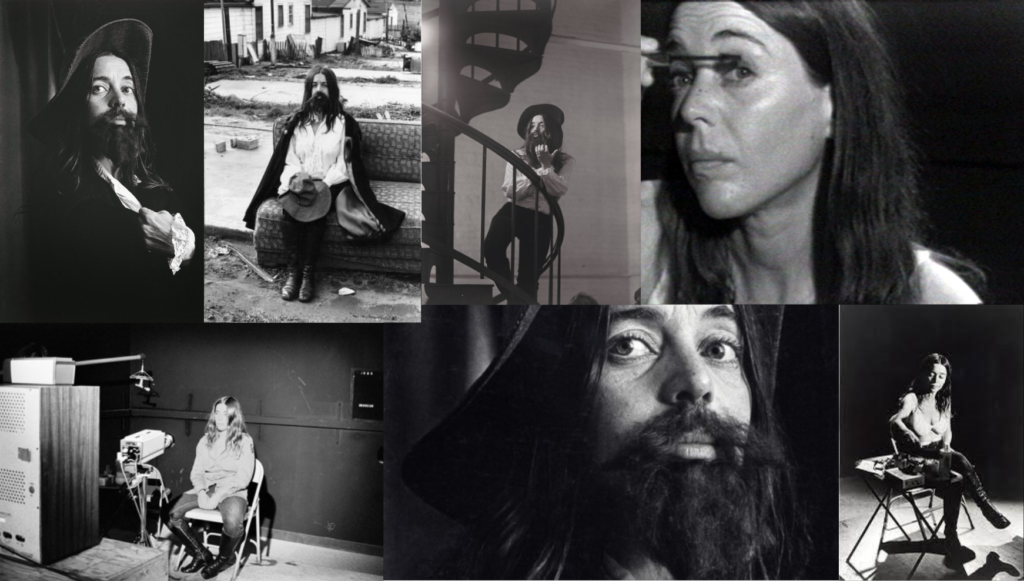
Eleanor Antin is an inspiration to Cindy Sherman’s work and she has said herself hat her Untitled Film Stills are related to the feminist performance work of the 1970s. Eleanor was an early influence to Cindy Sherman as she herself used to dress up and transform herself into multiple characters. s Her works are are considered conceptual, feminist classics such as “CARVING: A Traditional Sculpture”, “100 BOOTS”, where she created her 3 personas: The King, the Ballerina and the Nurse. Which he became particularly known for and helped her to gain fame and acknowledgement to express her message. Her multitude of characters explored the idea of roles and power, including how the artist is a subject in society. Eleanor critiques historical narratives and gendered power structures through fictional personas such as the three characters as they highlight different roles in society and hierarchies. This came in favour to Cindy as she took inspiration and decided to transform herself into different characters also. These two artists work are similar as they both use their bodies and self-representation as tools to critique identity, gender, and the roles women are assigned in society.
Eleanor Antin’s work themes consist of Identity, gender, history, the body, power, social roles, self-representation.
Cindy Sherman’s work themes consist of Gender, identity, representation, the male gaze, stereotypes, popular culture, societal roles.
Although these two artists also differ as Cindy Sherman’s work mainly focuses on deconstructing media representations of women, whereas Eleanor Antin’s work focuses more on exploring historical and social roles. I feel both these artists are essential to have knowledge on throughout this personal study as I have gained knowledge on different peoples interpretations on gender, identity and feminist views throughout history in order to create my own vision and my own message in response to other peoples work from the past.
Film Stills.

Untitled Film Still #10-
Wearing a hairstyle reminiscent of a Dorothy Hamill wedge cut, the heroine might be a working girl at the end of a rough day, caught just moments after her groceries have toppled to the floor. Maybe she’s someone’s girlfriend trying to prepare a nice dinner before her guy walks in the door. Perhaps she’s a struggling actress living on scrambled eggs and Campbell’s soup. None of these scenarios is right or wrong, but the essence is the same: a young woman is caught off guard by someone standing just outside the frame. Regardless of the narrative, the viewer is intrigued and unsettled by what will happen next.
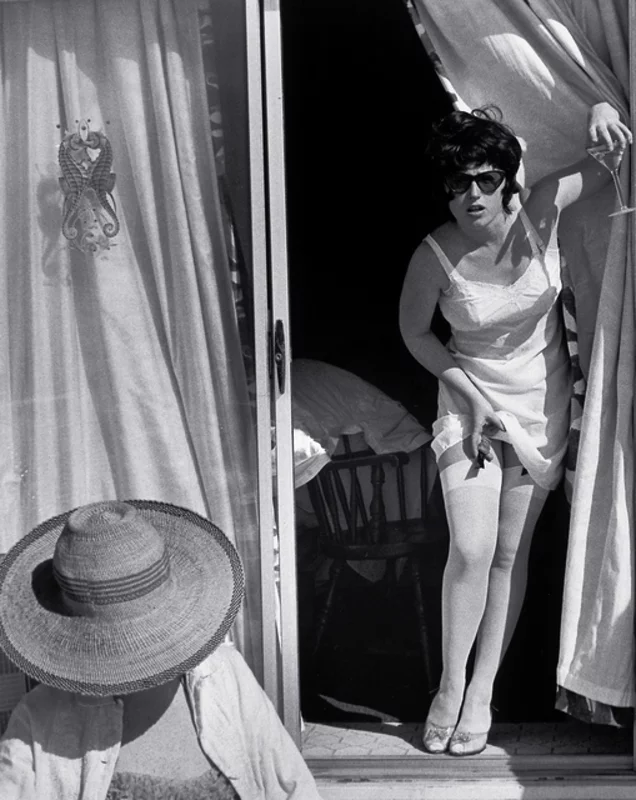
Untitled Film Still #7–
A floozy in a slip dress with garter exposed and martini in hand, Sherman looks up behind sunglasses and feigns surprise at an off-screen presence. She portrays a confused woman trying to grab the attention of someone or trying to communicate with someone. The persons Identity is concealed ad makes the viewer wonder who the woman is trying to gather the attention from and why.

Untitled Film Still #13 –
The woman appears to be reaching for a book, and her attention is directed upwards towards the shelf. She is depicted with a headband in her hair, and her attire suggests a look from a past era, possibly aligning with the late 1970s aesthetic, or perhaps even earlier, evoking the style of the 1960s. The scene mirrors those from mid-20th century films, where a character might be caught in a contemplative or decisive moment. She is not looking directly looking at the camera and she is displaying her vulnerability and role in society.

Sherman appears as a seductress, who is lying with a longing facial expression. She is looking worried and concerned, and is possibly longing for a sense of purpose or companionship during a lonely life without a specific purpose. Possibly speaking of one such image, she said, “To pick a character like that was about my own ambivalence about sexuality- growing up with the women role models that I had, and a lot of them in films, that were like that character, and yet you were supposed to be ‘good’.
I really like Cindy Sherman’s work and I hope to find similar photographers to her to demonstrate my vision. Although In my personal study I would not include pictures of only myself but also of other women. I really like how Cindy Sherman experimented with hair, makeup and costume to portray different characters and I would like to do the same. Researching Cindy Sherman’s work has helped me to understand a historical side to the male gaze and how times have changed, but not really. Society has still created an inaccurate.
I would possibly like to do a ‘Modern Day’ take on this or maybe choose a more ‘Past’ approach, or do a comparison of them both and include different interpretations of past times and modern times and show how different females live different lives according to identity, sexuality, wealth and lifestyle.
Photo Analysis.
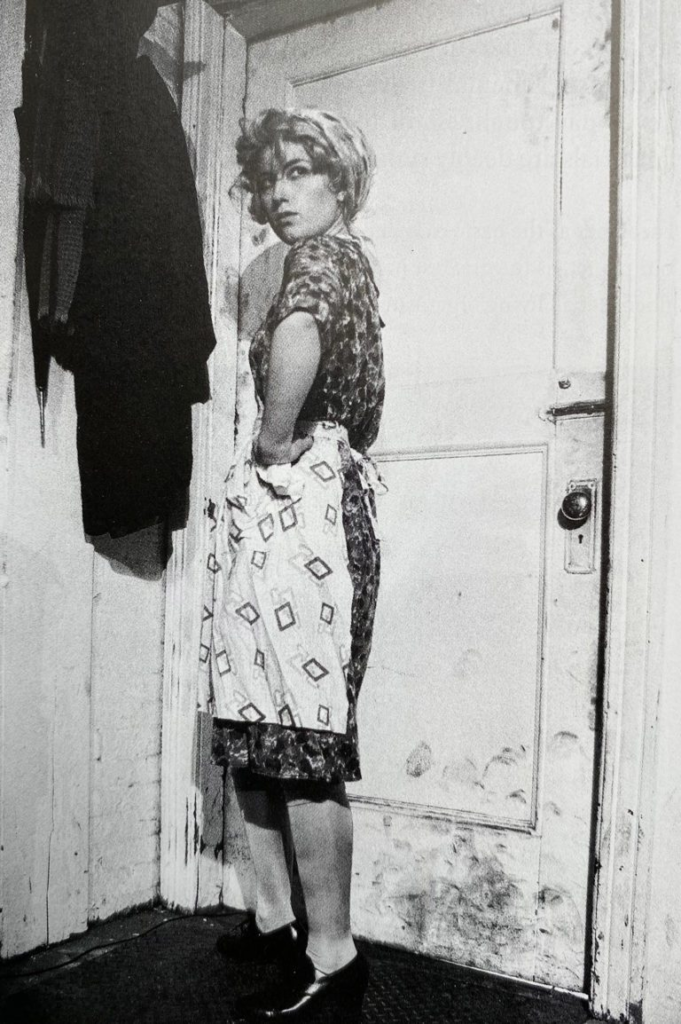
Technical:
The soft and naturalistic lighting in this photograph demonstrates that it is a photo from the past and is meant to display the time of the late 1970s. Which explains the low quality and slightly pixelated camera settings that are not very focused. I think that high contrast lighting, with a wide difference between highlights and shadows, brings a sense of intensity and depth to an image with dramatic qualities, which is what Cindy Sherman has done with her lots of her work. The aperture is also slightly blurred and has a higher sensitivity ISO which causes a grainier image with a lighter grey monochrome tone rather than cool colours. This black and white tonal structure has a colder impression which displays a sense of loneliness and emptiness in the image. The use of shadow and light in the Untitled Film Stills, heightens mood and tension, which isolates the subject within the frame. This dramatic lighting also helps to portray a specific genre of film such as drama, mystery or even horror. I think that Cindy Sherman’s use black and white photography is significant as it gives the images a sense of timelessness and universality, which provides the aesthetic of classic cinema.
Visual:
Accompanied with the black and white colour, this staged cinematic scene has meaning to it within its 2D format. The image has a woman as the central figure in the middle of the image with a door behind her stood in the corner of a room. There is also coats and clothing hung up to the left of the woman which has a dark black colour which attracts the viewers eyes towards the middle of the photograph, right next to the characters face. The photograph has a portrait angle which has been cropped into a tight famed rectangle shape. This framing of the images creates a cinematic feel to the photo and Her work mimics a multitude of low-budget narratives of different characters from 1950s-1960s television. Having settings such as homes, bedrooms, kitchens or streets conveys the message of domestic housewives living stereotypical lifestyles. The characters Cindy Sherman portrays are also seen as mid motion and candid to give a ‘frozen-in-time’ impression, this adds to the mystery and explains the deliberately vague stories that are without a clear plot. This frozen moment in time makes the viewer question the context, time-period and situation the character may be in whilst the photo is being taken. This image has no clear narrative unless the photo is deeply looked at and questioned. After establishing her outfit and role, the viewer is able to create an assumption on what the woman’s purpose is and it is then established that this is a small section of a much larger story.
Contextual:
Cindy Sherman’s Untitled Film Stills includes contextual layers that address essential historical issues of gender, identity, and media representation. She created these photographs throughout 1977-80s, however they are based on the 1950/60s. During this period of the 70s, second-wave feminism was arising and women were beginning to challenge gender roles and opinions on women in media products were being raised as women began to question and challenge their portrayal and how they were being objectified and seen as an object to please the male gender. The “male gaze” refers to the way women are depicted in visual culture for males, Cindy Sherman chose to display her cultural and social concerns about the roles and representations of women in tv, cinema and media products. This work is technically ‘mocking’ the media as the series of images contains a female subject that is both the object and the creator of her image. The roles she portrays are characters which may demonstrate a victim, an innocent woman or a seductress. This creates a way for Cindy Sherman to control the portrayal of female objectification as the turning the camera on herself to expose the true meaning behind these roles. In this image her portrayal of a working class woman can be seen by her outfit and demonstrates the time period this photo is alluding to and women’s’ role during this time.
Conceptual:
This photo explores the male gaze. As number 80 film stills, became iconic. Chose herself for the model. Washerwoman maid in a feminist move way to redirect the male gaze to show she was in charge. Her angry expression by looking over her shoulder at us to show she is ‘done‘ and wants to find an escape from her current position as a housewife or domestic worker and move onto bigger dreams. She is stood slightly hunched and is wearing an apron and a blouse which shows the viewer that she is lower class and is ‘insignificant’. She is mid- movement and has a slightly distracted expression on her face whilst not making direct eye-contact with the camera which demonstrates her vulnerability and distraction. The message from Cindy Sherman portrays the reality of a ‘happy housewife’ who is safe and content at home when in reality, they are lonely and struggling mentally. The lack of context to this images, causes the reader to assume and create their own interpretations on the photo. The vulnerability, beauty and individuality of the character makes the audience feel sorry for the woman and feel a sense of reflection and remorse for women during this period.